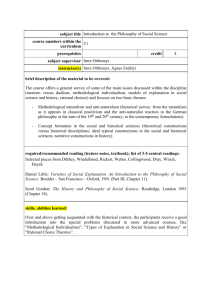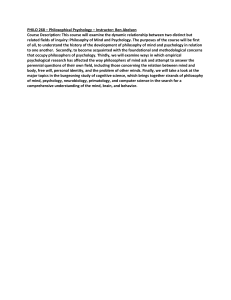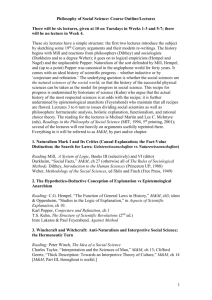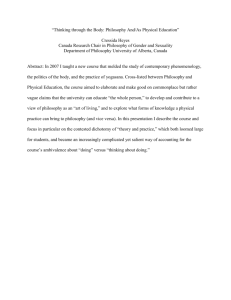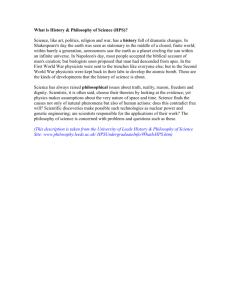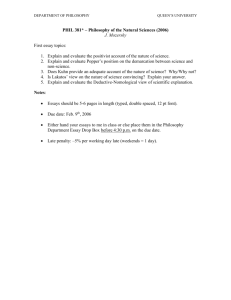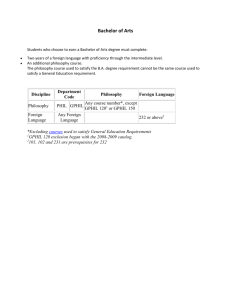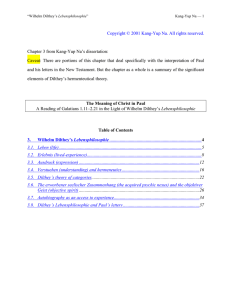Methodology of the Sciences
advertisement
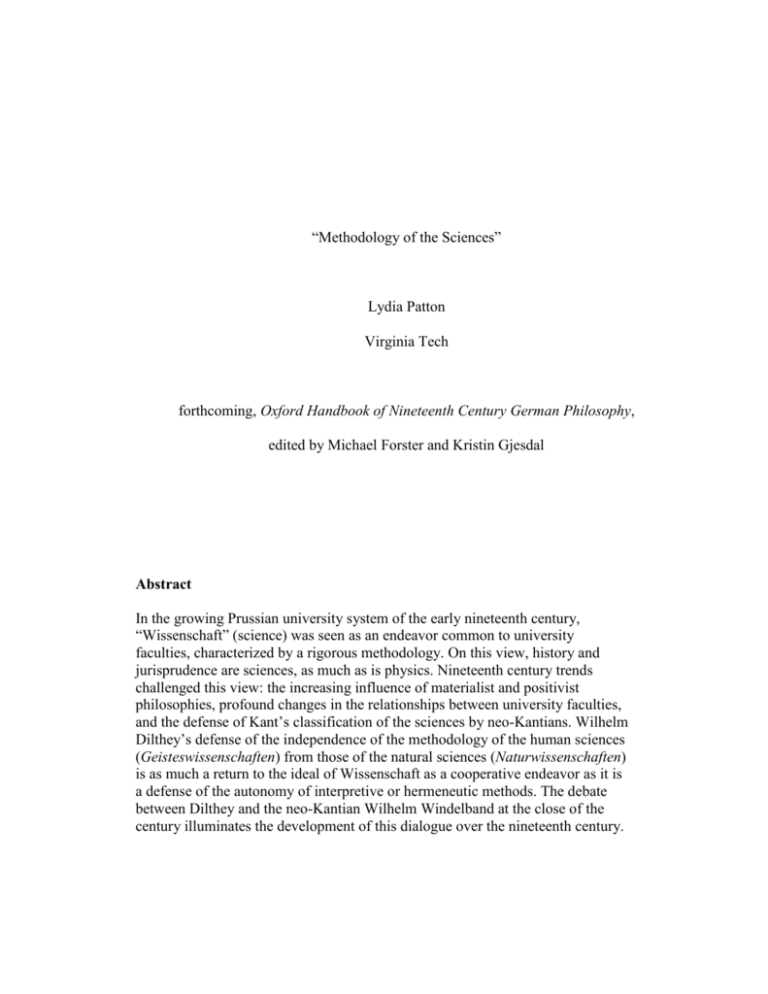
“Methodology of the Sciences” Lydia Patton Virginia Tech forthcoming, Oxford Handbook of Nineteenth Century German Philosophy, edited by Michael Forster and Kristin Gjesdal Abstract In the growing Prussian university system of the early nineteenth century, “Wissenschaft” (science) was seen as an endeavor common to university faculties, characterized by a rigorous methodology. On this view, history and jurisprudence are sciences, as much as is physics. Nineteenth century trends challenged this view: the increasing influence of materialist and positivist philosophies, profound changes in the relationships between university faculties, and the defense of Kant’s classification of the sciences by neo-Kantians. Wilhelm Dilthey’s defense of the independence of the methodology of the human sciences (Geisteswissenschaften) from those of the natural sciences (Naturwissenschaften) is as much a return to the ideal of Wissenschaft as a cooperative endeavor as it is a defense of the autonomy of interpretive or hermeneutic methods. The debate between Dilthey and the neo-Kantian Wilhelm Windelband at the close of the century illuminates the development of this dialogue over the nineteenth century. A classic debate over the difference in methodology between the Geistes- and the Naturwissenschaften, usually translated as the human and the natural sciences, took place between Wilhelm Dilthey and Wilhelm Windelband in the late nineteenth century. The debate between Dilthey and Windelband does not turn on the same questions as do post-nineteenth century discussions that are more widely known. Instead, the Dilthey-Windelband debate has its roots in upheavals in German university and research practices at the beginning of the nineteenth century. The debate, and the nineteenth century discussions more generally, certainly are relevant to discussions of whether true science has a necessarily a priori or law-governed (nomothetic) core. But they are also relevant to the question of how to construct research programs that involve cooperation between sciences, and to broader questions of interpretation and understanding in theory assessment. 1. The Nineteenth Century Context Perhaps the most familiar context in which philosophers are used to viewing the debate over the independence of the human sciences is the defense, by Heidegger and Gadamer, of the independence of their hermeneutic theories from the logical positivist thesis of the unity of science. The debate between Heidegger and Carnap on language and metaphysics is emblematic of this split.1 Because Windelband defends the nomothetic (law-governed) foundations of the physical or natural sciences, and Dilthey defends the “independence” of the human sciences, it is tempting to analyze the debate between Dilthey and Windelband as an earlier manifestation of the conflict between Carnap’s and Neurath’s unity of science and Heidegger’s and Gadamer’s hermeneutics. 1 See Greg Frost-Arnold, “The Large-Scale Structure of Logical Empiricism” (Philosophy of Science 72 (5), 2005), 826-838. 1 This would be a mistake. Windelband was not defending the unity of science or of scientific language. Instead, he defended essential distinctions between types of science. Dilthey was not defending hermeneutics in the Heideggerian or Gadamerian sense. Rather, he was defending an earlier version more akin to that of Herder and, especially, Schleiermacher, the philosopher who had been the focus of most of Dilthey’s early career. Finally, the debate between Dilthey and Windelband had less to do with the overcoming of metaphysics than with the status of distinct types of science, and the relationships between them. This is partly due to Dilthey’s and Windelband’s own philosophical views, but it is also influenced strongly by the nineteenth century context. The nineteenth century saw a renewal of the German (then Prussian) university system, with the founding of the University of Berlin in 1810. Wilhelm von Humboldt, Fichte, and Schleiermacher saw the universities as dedicated to a particular ideal of Wissenschaft. The word usually is translated into English as “science,” but this does not capture the domain to which “Wissenschaft” was applied, especially in the early part of the nineteenth century. As John Merz points out, “Fichte, whose whole doctrine was, according to French and English ideas, almost the reverse of scientific, uses the word Wissenschaftslehre to denote and characterize his system.”2 Merz continues, In fact the German word for science has a much wider meaning than science has in French or English; it applies alike to all the studies which are cultivated under the roof of alma mater; it is an idea specially evolved out of the German university system, where theology, jurisprudence, medicine, and the special philosophical studies are all said to be 2 John Theodore Merz, A History of European Thought in the Nineteenth Century, vol. 1. (Edinburgh: William Blackwood, 1907). 2 treated “scientifically,” and to form together the universal, all-embracing edifice of human knowledge (p. 170). In its classic expression, Wissenschaft was a term for a intellectual endeavor shared by researchers at the university. The university faculties were intended, not as separate institutions with distinct specialties, but as departments of a single enterprise working cooperatively. The universities of Jena and of Berlin became well known for work that fell squarely within the classic ideal. In Berlin, the work of Leopold Ranke in history, Friedrich Schleiermacher in hermeneutics, and von Humboldt in history and in language exemplify the ideal of Wissenschaft as it was understood early in the nineteenth century. In Jena, the Romantic tradition associated with Goethe and Schelling, which blends research into natural science with humanistic inquiry, had its Blütezeit during the first half of the century. By the middle of the nineteenth century, the positivist and empiricist philosophies of Auguste Comte and John Stuart Mill had made their way into translation, and into discussions of scientific methodology. Closer to home, German materialism, spearheaded by Emil du BoisReymond, was in its prime in the 1850s and 1860s. The broad definition of the word Wissenschaft came under increasing pressure throughout the nineteenth century. Merz traces this pressure to the increasing influence, in Germany, of the quite different French and British definitions of scientific research, along with the impressive progress made in the empirical and formal sciences over the nineteenth century. But there were also more philosophical pressures, coming from the materialist, empiricist, and positivist philosophical traditions. Moreover, during this time, the faculties of philosophy expanded to include natural sciences, including chemistry and physics.3 Researchers in the philosophical and medical 3 See, e.g., Margit Szöllösi-Janze, “Science and Social Space,” (Minerva 43, 2005): 339-360. 3 faculties did work in biology and in physiology. One of the greatest physiologists and physicists of the nineteenth century, Hermann von Helmholtz, was trained in the medical faculty. The ideal of the scientific researcher also underwent a change. Wilhelm von Humboldt’s brother Alexander was a significant stimulus for this change, embarking on lengthy voyages of discovery and research into living and geological phenomena. When Alexander returned from his voyages in the 1820s, he inspired others, including Johannes Müller, Ernst Haeckel, and even Charles Darwin, to take voyages of their own.4 Humboldt, Müller, Haeckel, and Darwin clearly were engaging in scientific research. But, while all were academics, this research was not done within the university system, within the traditional Fakultäten. Similarly, in 1845 Gustav Magnus formed a group that later became the Berlin Physical Society. Though Magnus was a professor at the University, the Berlin Physical Society was an independent research group, which met at Magnus's home and used his private laboratories for scientific research. Later, Emil du BoisReymond and Werner von Siemens founded similar laboratories and research groups outside the university.5 Freud and Helmholtz were among the talents who cut their teeth on this extrauniversity laboratory system. I concur with Reill, then, in arguing that we ought not to conceive of the narrative of the Geisteswissenschaften that emerged in the nineteenth century as a reaction to “Enlightenment 4 Robert Richards, “Biology,” in From Natural Philosophy to the Sciences, ed. David Cahan (Chicago: The University of Chicago Press, 2003), 17-18. 5 See, among others, Sven Dierig, Wissenschaft in der Maschinenstadt (Göttingen: Wallstein Verlag, 2006), and Frank Sulloway, Freud: Biologist of the Mind (Cambridge: Harvard University Press, 1992). 4 scientism.”6 The pressures were more immediate. Emil du Bois-Reymond, Eduard Zeller, and others gave famous lectures in which they advised that philosophy and history restrict themselves to the methods of the empirical, or natural, sciences. The universities at Berlin and at Jena were arenas of constant debate about the relative merits and methodologies of the empirical sciences and of the disciplines of philosophy, philology and linguistics, and history. Beginning in the 1830s and 1840s, an extraordinary group of scholars taught at the Friedrich-Wilhelms-Universität, now the Humboldt-Universität, in Berlin. These included Adolf Trendelenburg, Emil du Bois-Reymond, and Heymann Steinthal, whose close associate Moritz Lazarus would join him in the 1870s. Meanwhile, the university at Jena was the academic home of luminaries including Karl Reinhold, J. G. Fichte, G. W. F. Hegel, Friedrich Schelling, Wilhelm von Humboldt, and Friedrich von Schlegel. Later, Kuno Fischer and Gottlob Frege joined the faculty. The university at Jena fostered the beginnings of the Southwest School of neoKantianism to which Wilhelm Windelband belonged, which later took root in Baden. In the 1830s, the topic of Erkenntnisstheorie, loosely translated as the theory of cognition, began to gain traction in the universities. Überweg remarks that “This turn toward the theory of knowledge brought a renewed connection to Kant along with it.”7 Nonetheless, developments in the sciences, even in the very early parts of the nineteenth century, put into question certain elements of Kant's theory of the sciences. Kant’s model for law-governed explanation in the natural sciences is Newtonian physics. In the Metaphysical Foundations of Natural Science, 6 Peter Reill, “Science and the Construction of the Cultural Sciences in Late Enlightenment Germany” (History and Theory 33 (3), 1994), p. 345 and passim. 7 Friedrich Überweg, Grundriss der Geschichte der Philosophie. Vierter Teil (Basel: Verlag Benno Schwabe & Co, 1951 [1868]), 310. 5 Kant remarks that “in every special doctrine of nature only so much science proper can be found as there is mathematics in it.”8 Using this criterion, Kant disqualifies biology and psychology as proper sciences. Over the nineteenth century, biology and psychology proved to be particularly interesting cases. Materialism, positivism, and empiricism in philosophy and in science blended new advances in empirical psychology and in the physiology of perception with philosophical methods and analysis, in conceiving the basis for knowledge of external phenomena. (Empirical psychology and physiology of perception were often indistinguishable during this period.) David Hume and John Locke established early version of the “science of man” project, based on the desire to investigate the operation and limits of the human mind as a basis for the study of human knowledge.9 Hume turns the methods of natural science, especially observation and induction, on the human mind in endeavoring to become the “Newton of the mind.” At the end of the eighteenth century, in Kant’s view, there was still no true Newton of the mind: no general mathematical laws for the association of impressions had been given. In the first half of the nineteenth century, work by Johann Friedrich Herbart, Wilhelm Wundt, and Theodor Fechner, among others, contributed to the founding of empirical psychology as a science demonstrably governed by, if not Newtonian laws, at least dynamic principles. As Herbart puts it, It is alleged…that mathematics treat only of quantities, whereas actions and states of greatly different qualities of are the subject of psychology. [...] It may be sufficient to 8 Immanuel Kant, Gesammelte Schriften, hrsg. Bd. 1-22 Preussische Akademie der Wissenschaften (Berlin 1900f.), Ak. 4:470. 9 John Locke, An Essay concerning Human Understanding, in The Works of John Locke vol. 1. (London: Henry G. Bohn, 1854 [1690]), 132. 6 assert that however great the number of fictitious qualities which a man may distinguish in his mind, he certainly cannot deny that over and above them there is an infinite variety of quantities determining mental action.10 Herbart argues that his laws aim to describe the quantitative variation of sensations and of thoughts, and their association and interaction with each other, in the same way that Newton's mechanics describes the interaction of material phenomena (pp. 253-4). Over the nineteenth century empirical psychologists and physiologists of sensation turned the methods of the empirical sciences on psychology, using observation to record responses to stimuli, as one would record the movement of an object in response to impact in physics.11 In general, the nineteenth century saw the analysis of waves, whether of sound or of light, put on a rigorous mathematical foundation, which in turn allowed for unprecedented advances in the qualitative analysis of sensation. Kant's criterion that any true science ought to be founded on mathematics now seemed to allow psychology, at least, to be treated as a proper science. There are several ways to interpret these developments, each with methodological consequences. One approach is to question Kant’s classification. If psychology has a mathematical foundation similar to Newton’s mechanics, then Kant’s exclusion of psychology from the status of a true science is mistaken. Another possibility is to argue, as Hume had earlier, that the true methodological foundation even of Newton’s science is inductive, not deductive, and to argue on these grounds for the methodological unity of psychology and physics. This was 10 Johann Herbart, “Possibility and Necessity of Applying Mathematics in Psychology,” trans. H. Haanel. (Journal of Speculative Philosophy 11, 1877), 255. 11 See, e.g., Gary Hatfield, The Natural and the Normative (Cambridge, MA: MIT Press, 1990), ch. 5. 7 the approach taken by John Stuart Mill (1806-1873). Mill argues, in his System of Logic, for a set of rules of induction based on associationist psychology.12 Mill insists that not only associationist psychology, but also our account of scientific theory building must restrict itself to claims that can be given a justification using the methods of the empirical sciences. His views on this score are one of the motivations for the well-known debate between Mill and William Whewell (17941866). Even Millian and Humean associationism rely on ampliative inference, however. They allow for rules of association that have a broader validity than their original inductive basis. Another approach to psychology, in its relationship to epistemology, was to argue that psychology and physics both describe the properties and interaction of matter, and that all scientific explanation is in essence a description of material phenomena. This materialist position gained adherents in the mid-nineteenth century, with a particular flowering of German materialist works in the 1850s: Ludwig Büchner, Force and Material (1855), Jacob Moleschott, The Circulation of Life (1852), Carl Vogt, Superstition and Science (1855), and Heinrich Czolbe, The New Presentation of Sensualism (1855). These materialist philosophers, many of whom were scientists, derived from psychology and the physiology of perception the view that mental phenomena and physical phenomena both are manifestations of the properties of matter, so that there is no essential difference between them. The human sciences are equivalent to the natural sciences: history and sociology are governed by natural laws, the same kind of natural laws as those governing the motion of the planets. 12 John Stuart Mill, A System of Logic, reprinted vols. 7-8 of Collected Works of John Stuart Mill, ed. J. Robson. (Toronto: University of Toronto Press, 1843). 8 2. The Geisteswissenschaften and the Naturwissenschaften By the third quarter of the nineteenth century, materialism and positivism had made significant gains, especially in Germany and in Britain. The methods of the natural sciences had been refined as well, both in the domain of experiment, and in the formal, mathematical foundations of the sciences. The tradition of the Geisteswissenschaften is to defend the independence of a domain of questions from the resulting trend of appeal to the explanatory methods of the natural sciences as fundamental or even exhaustive. In his analysis of the Geisteswissenschaften, Dilthey responds to what are seen as defects in both sides of the argument between materialism and idealism.13 Dilthey sees Hegelian and Fichtean idealism as removing human agency from its natural environment into a noumenal or ideal realm, even though the material environment provides the stimuli for, and materials for the implementation of, thoughts and ideas. On the other side, he saw materialist and positivist accounts of history and of sociology as lacking purchase on questions of meaning and culture that are the particular subject matter of the human sciences. In response, Dilthey developed a theory of history influenced by the historian Johann Gustav Droysen (1808-1884).14 In a series of articles and books in the 1850s and 1860s, Droysen 13 For more background on Dilthey, see among others Rudolf Makkreel, “Wilhelm Dilthey,” The Stanford Encyclopedia of Philosophy, ed. Edward Zalta, URL = <http://plato.stanford.edu/archives/sum2012/entries/dilthey/>, 2012. 14 Frederick Beiser, The German Historicist Tradition. (Oxford, United Kingdom: Oxford University Press, 2012), 298. Further references to this text will be abbreviated GHT, followed by page number. Here see also William Kluback, Wilhelm Dilthey’s Philosophy of History (New 9 responded to the British positivist historian Henry Thomas Buckle (1821-1862), and to the growing influence of Mill, who had been introduced in Germany and in translation since the 1840s (WDPH, p. 30). Buckle argues for determinism in human history, arguing that human behavior is subject to the same laws as the weather or the motion of the planets, a position quite similar to that of the German materialists. Droysen responds by defending the independence of the methods of the historical sciences. In his Outline of the Principles of History of 1867, Droysen distinguishes between three methods of knowing. The method of philosophy is to know (erkennen); the method of history to understand (verstehen), and the method of science to explain (erklären). As Beiser (2012) draws from Droysen’s lecture notes, these methods are distinguished as follows: “To know is to derive from first principles; to explain is to subsume under general mathematical laws; and to understand is to interpret or translate, to make someone’s meaning comprehensible to me by putting it in my own terms” (298). Beiser points out that this typology anticipates Dilthey’s own early analysis of understanding. According to Dilthey, the natural sciences explain (erklären), while the human sciences seek to understand (verstehen).15 In his seminal Introduction to the Human Sciences of 1883, Dilthey introduces his own notion of understanding, which he conceives in response to the “historical school”, to positivism, to the hermeneutic tradition, and to German Idealism. The historical school, including Ranke and Droysen, investigate the phenomena as they arise in history, and consider them to be constituted by human action and by York, NY: Columbia University Press, 1956), ch. 1. Further references to this text will be abbreviated WDPH, followed by page number. 15 See, e.g., the essays in Uljana Feest, ed, Historical Perspectives on Erklären and Verstehen (Dordrecht: Springer, 2009). 10 context. Dilthey remarks that, while this tradition has been fruitful, it excludes “a link with the analysis of facts of consciousness.”16 The historical school analyzes the phenomena of human history externally, but does not examine the contribution of “epistemology [Erkenntnisstheorie] and psychology” to history. Dilthey’s basic argument for the independence of “understanding” is relatively simple.17 1. Particular events are not the analysanda of history. Rather, the aim of history is to put a given event or view into its context. In the case of an idea, this is studied as an expression of the individual, but where individual expression is conditioned by a. Cultural and material conditions, and b. The categories of thought of the individual. 2. The individual’s expression may become part of the cultural background, which in turn influences the ideas of others, which constitute new background categories. 3. (1a) can be studied profitably as using the methods of the natural sciences. But (1b) and (2) cannot. a. (1b) requires inquiry into an individual’s ideas. b. (2) is an ongoing process that cannot be limited to a determinate space and time. Therefore, Dilthey concludes, the methods of the human sciences must be independent of the methods of the natural sciences. Understanding the categories of thought of an individual 16 Wilhelm Dilthey, Introduction to the Human Sciences, volume 1, tr. Ramon Betanzos. (Detroit: Wayne State University Press, 1988 [1883]), 72. Further references to this text will be abbreviated IHS, followed by page number. 17 This argument is not intended to be formally valid, of course. It is summarized from Dilthey’s account in IHS, ch. 3. See also WDPH p. 59. 11 requires interpreting her expressions as indications of her conceptual framework, i.e., employing the methods of understanding. Moreover, the study of the influence of ideas and theories on others requires adopting a large-scale theory regarding the change of concepts and ideas over time. Neither of these are explicitly provided for by the methods of the natural sciences. A materialist may disagree with the premise (3a) for obvious reasons – for her, ideas are material. Without an antecedent commitment to the notion that ideas are independent of matter, (3a) is not a good argument for the independence of the human sciences from the natural sciences. But (3b) is more intractable. It is not easy to see how the evolution of theories, and of conceptual frameworks in general, over time can be analyzed using the methods of the natural sciences. We might describe these methods pluralistically, as laboratory research, inductive generalizations, and causal inferences. These methods are not obviously adapted to investigating the relationship between ideas and history. Any particular theory can be evaluated on the validity of its inductive inferences or the accuracy of its predictions. But that will not allow us directly to evaluate the influence of one theory or conceptual framework on another, for example. Dilthey maintains that his analysis allows for a middle path between overestimating the particularity of individual ideas, and defending an overly idealist account of history. When Dilthey was at university, he had a close relationship with Moritz Lazarus and Heymann Steinthal (WPDH chs. 1-2, GHT p. 343). While they were influenced by Herbartian psychology, Lazarus and Steinthal object that Herbart neglects the historical, linguistic, and cultural dimensions of human existence and action. For an account of these, they turned to Humboldt and to Hegel, though in a critical spirit. Steinthal wrote a substantial monograph, Wilhelm von Humboldt’s Linguistics and the Hegelian Philosophy (1848), which compares Humboldt to 12 Hegel, and finds a middle path. In 1863, Lazarus gave a Rektoratsrede, “On Ideas in History,” in which he also argues against accepting wholesale either Hegel's dialectic or Humboldt's humanism.18 Lazarus argues that Hegel’s thought removes the ideas too strictly from the material conditions of society, and thus it is unclear how we are to have access to them. Humboldt, on the other hand, argues that ideas have impact through the agency of individuals, who bring those ideas to fruition. But, Lazarus objects, individuals do not control the impact of their ideas on society, because they do not control material conditions, nor other individuals. Lazarus locates the contribution of reason to history in the influence of ideas on thoughts and actions, as these are made manifest in cultural artefacts and historical phenomena. Lazarus concludes that the only way to study ideas in history is to achieve a comprehensive perspective on an individual's thoughts and actions as they are revealed in history, so that one can reason from the cultural artefact to the idea behind it. In this context, Dilthey also appeals to the hermeneutic tradition, especially to Friedrich Schleiermacher (1768-1834) and Johann Gottfried Herder (1704-1803).19 In his Ideas for the Philosophy of the History of Humanity (1784-1791), Herder defends the thesis that thought depends on language. Language is an indication of thought; but thought is made possible by 18 Moritz Lazarus, Über die Ideen in der Geschichte (Berlin: Ferdinand Dümmlers Verlagsbuchhandlung, 1865), 41n. 19 See Michael Forster, “Hermeneutics,” in The Oxford Handbook of Continental Philosophy, ed. Michael Rosen and Brian Leiter. (Oxford: Oxford University Press, 2007) and “Herder’s Philosophy of Language, Interpretation, and Translation” (Review of Metaphysics 56 (2), 2002), 323-356 for the background, motivations, and arguments of hermeneutic theory in the eighteenth and nineteenth centuries. 13 language in the first place. Herder faces the larger question of how to interpret a text as a whole, as an expression of a given content, where this content may or may not be read as determined by authorial intention. Herder and Schleiermacher appeal to the notion of feeling or divination (Einfühlung), which Gjesdal parses as “attentiveness to the individuality of symbolic expression as it lends voice to a larger cultural context.”20 While Herder and Schleiermacher appeal to a notion of “divination” in their hermeneutic methods, they do not argue that the methods of the human sciences are distinct from those of the natural sciences. As Beiser observes, Herder explicitly argues that the “laws that govern history are one and the same as those that govern nature” (GHT p. 100). Herder’s or Schleiermacher’s interpreter uses Einfühlung as a way to investigate a text as evidence. Dilthey’s relationship with Lazarus and Steinthal may explain Dilthey’s similar commitment to a distinct path between Humboldtian individualism and Hegelian idealism.21 Dilthey also followed Lazarus, Steinthal, Herder, and Schleiermacher in locating the study of the individual, not in conceptual analysis or in empirical psychology alone, but in a holistic study of history, culture, language, and psychology. For Dilthey, the methodology for the human sciences is found in the entirety of human experience and culture: I compare every element of current abstract scientific thinking with the whole of human nature presented by experience, the study of language, and the study of history, and I look for their interrelationship (IHS p. 73). 20 Kristin Gjesdal, “Aesthetic and Political Humanism” (History of Philosophy Quarterly 24 (3), 2007), 281. 21 For Dilthey’s objections to their views, see Kluback, 35-36. 14 Dilthey’s strongest argument for the independence of the human sciences is based on this holism. Dilthey does give individual arguments that specific results in the human sciences are based on introspection or on hermeneutic methods. But he shies away from arguing that psychology or the analysis of introspective evidence yields a foundation for the human sciences (see also GHT p. 339ff.). The holistic method rules out the approaches of earlier philosophers of experience. In my view, this is the right context in which to read Dilthey’s famous remark that “There is no real blood flowing in the veins of the knowing subject fabricated by Locke, Hume, and Kant, but only the diluted juice of reason as mere mental activity” (ibid.). For Dilthey, the human sciences aim, not at an analysis of consciousness or of history alone, but at a holistic understanding of the “totality of human nature,” through study of the material and ideal facts of history and of culture (ibid.). In founding the human sciences on a holist methodology, Dilthey returns to the earlier ideal of Wissenschaft as a cooperative endeavor. This ideal is distinct from the Kantian and neoKantian position, according to which the empirical and “historical” sciences are strictly separate from those sciences with an a priori foundation. Kant carefully distinguishes the two, for instance, in his essay “On the Conflict of the Faculties.” Wilhelm Windelband (1848-1915), a key member of the Southwest School, defended the autonomy of philosophy, especially, from the methods of empirical science. He did so in part in response to a well-known lecture of 1867 by Eduard Zeller, “On the Meaning and Task of Philosophy,” in which Zeller argued that philosophy should adopt the methods of the empirical sciences (see GHT p. 375ff.). In his 1894 Rektoratsrede in Strasbourg, Windelband responds by upholding Kant's distinction between the methods of the rational and the empirical sciences. The rational sciences 15 are the a priori sciences, mathematics and philosophy; while the empirical sciences are those based on experience, such as biology and chemistry. Philosophy follows the critical method, which establishes the quid juris in Kant’s sense, i.e., the “reasons for knowledge, the evidence for its validity”; whereas history follows the genetic method, which establishes the quid facti, i.e., the “causes of knowledge, how it originates from experience and the innate activity of the mind” (GHT p. 376). Windelband reiterates Kant’s view that the empirical sciences require “the verification of facts on the basis of observation,” and the rational sciences “are never based on single observations or collections of observations” (pp. 173).22 What is new with Windelband is the division of the methods of the empirical sciences into idiographic and nomothetic: the empirical sciences either seek the general in the form of the law of nature or the particular in the form of the historically defined structure. On the one hand, they are concerned with the form which invariably remains constant. On the other hand, they are concerned with the unique, immanently defined content of the real event. […] scientific thought is nomothetic in the former case and idiographic in the latter case (GN p. 175). Nomothetic sciences aim to find general laws, while idiographic sciences focus on individual phenomena that may not be law-governed or exhibit regularities. Windelband defines idiographic sciences as those which seek “the particular in the form of the historically defined structure”. On 22 Wilhelm Windelband, “Strasbourg Rectorial Address,” trans. of “Geschichte und Naturwissenschaften” by Guy Oakes (History and Theory 19 (2), 1980 [1894]), 173. Further references to this text will be abbreviated GN, followed by page number. 16 Windelband's account, then, history appears to be essentially idiographic; and Dilthey’s method of understanding is as well. Windelband begins his lecture by criticizing two nineteenth century tendencies: on the one hand, to argue that philosophy is no longer a living discipline and is now only the history of philosophy; or, on the other hand, to place psychology at the foundation of the philosophical method (GN p. 170). He is concerned to preserve the independence of the philosophical method from the methods of history and of psychology (GN pp. 170-171). He continues by rejecting the division between the natural and the human sciences, observing that psychology itself is a problem case - it must be considered a “Geisteswissenschaft” or human science, since its subject is the human Geist, but its “methods are those of the natural sciences” (GN p. 174). For these reasons, Windelband also criticizes Dilthey’s theory of the human sciences, especially of history. Windelband argues that, while psychology may be as much a nomothetic science as is physics, history is a paradigmatically idiographic science. “Historically defined structures” are constituted by their particularity and individuality. On several significant points, Windelband and Dilthey were talking past each other. Windelband's aim in his Rektoratsrede is to make the true distinctions between sciences, and he argues that the division of sciences into Geistes- and Naturwissenschaften is incorrect. He goes on to say that the Geisteswissenschaften rely on a kind of “inner perception” or self-observation, described by Locke and by Descartes, that can no longer be relied upon as a foundation for scientific inquiry (GN p. 173). However, Dilthey’s approach does not necessarily rely on “inner perception.” Rather, Dilthey employed a comparative approach, in which he brought the methods of history, of psychology, and of language together. Those methods could be entirely external 17 and based on the analysis of empirical evidence through hypotheses, as are the hermeneutic methods of Herder and Schleiermacher. One way to read at least some of Dilthey's work is to observe that he was not necessarily defending an essential division between types of science. Instead, he was defending his version of the Humboldtian ideal of Wissenschaft, as a collective endeavor to investigate not only knowledge, but human experience and the meaning of human action in history. The method of understanding, and the application of hermeneutic and psychological methods in history and in the analysis of language, could solve questions about “the unity of life in the person, the outer world, individuals apart from us, their life in time, and their influence on each other,” which are things we can explain from this totality of human nature […] It is not the assumption of a rigid a priori of our cognitive capacity, but only the history of development alone […] which can answer the questions we all have to address to philosophy (IHS p. 73). While Windelband focuses on classifying the sciences methodologically, Dilthey focuses on conceiving how researchers and intellectual pursuits can cooperate. 3. History and methods Dilthey and Windelband are both opposed to materialism and positivism. But their responses are revealing about their antecedent philosophical commitments, and, perhaps more significantly, about their views on the relationships between disciplines and research programs. From Windelband’s perspective, materialism as an exhaustive account of the sciences threatens the independent validity and normative force of the a priori sciences. But Windelband does not see history itself as a true, nomothetic science; again, for Windelband, history is idiographic. 18 This view of history was not shared universally in the nineteenth century. Hegel, of course, was opposed to it; in his Philosophy of History, he distinguishes first-hand reports from reflective and philosophical history as distinct levels of historical reasoning. While Marx argues against Hegel that the norms of history are natural laws, not ideal relationships, arguably, both Hegel and Marx would disagree with Windelband and argue that history can be nomothetic.23 Windelband can agree that reasoning about historical relationships contribute to our understanding. But, in a Kantian spirit, he contends that such reasoning is not truly scientific. Instead, reasoning about the evolution of a concept or about the Zeitgeist, for instance, constitutes subjective reflections on our experience, which allow us to understand our experience more fully. But such subjective forms of interpretation have no objective validity, that is, they ought not be applied to objects and to events as though they allow for judgments about objective reality. The debate between Windelband and Dilthey is reflected in, at least, two later discussions of philosophy, in its relationship to the sciences. The first is raised by Windelband: the extent to which the search for law-governed relationships is not only central to, but definitive of, the methods of the natural sciences. Carl Hempel has defended perhaps the strongest position that the hypothetico-deductive method is characteristic of the explanation in the natural sciences, which can be seen as an iteration of Windelband’s view that nomothetic explanations are characteristic of natural science.24 However, distinguishing the hypothetico-deductive method 23 See, e.g., John Stanley, “Marx’s Critique of Hegel’s Philosophy of Nature” (Science and Society 61 (4), 1997), 449-473. 24 Carl Hempel, “Aspects of Scientific Explanation,” in Aspects of Scientific Explanation and Other Essays in the Philosophy of Science (New York: Free Press, 1965). 19 from the inductive method requires making a clear distinction between theoretical and observation statements. Rudolf Carnap, perhaps the strongest defender of such a distinction in his earlier work, comes to a much more conventionalist view by mid-twentieth century, when he writes “Empiricism, Semantics, and Ontology.” In general, the debates between Carnap and Quine over the relationship of language to scientific inference, over semantics versus syntax in evaluating scientific theories and linguistic frameworks, and especially over the use of inductive versus deductive methods in constructing scientific theories, can be read as a further development of debates over the proper methods of theory construction and evaluation in the natural sciences. Hempel’s view on nomothetic explanation further is put to the test by recent work on the importance of scientific understanding, which addresses the question of how to carve theories into elements that contribute to explanation versus understanding of the phenomena in question.25 Moreover, dividing the natural from the human sciences may make it appear that natural science makes no attempt to give an interpretation, not just a phenomenal description, of nature. But it is a vexed question now, as it was in the nineteenth century, what relationship there is between the mathematical or more purely theoretical statements, even of physical theories, and their interpretation. Can theories, like nature, be carved at the joints, to show which elements are justificatory, which explanatory, and which contribute to understanding? A second, less often addressed, question is raised by Dilthey’s work. The question concerns the interrelationship between scientific theories and pursuits, where history, psychology, and theory of language are taken to be scientific. In the sciences themselves, the 25 Henk de Regt, Sabina Leonelli, and Kai Eigner, Scientific Understanding: Philosophical Perspectives (Pittsburgh: University of Pittsburgh Press, 2009). 20 scope of contemporary research projects, in which no one person can complete a given project, and scientists of various kinds of training and background must cooperate, has provoked discussion of how this fact affects the practice and the epistemology of science. A clearly conceived ideal of a common methodology, or at least of common aims and practices, might resolve problems encountered by cooperative intellectual enterprises. Dilthey's own work probably does not succeed in articulating such an ideal, but should be valued for its appreciation of the importance of cooperation in the methods of the sciences. Moreover, Dilthey’s notion of the Geisteswissenschaften reflects the earlier concept of Wissenschaft as a shared, cooperative research program. The development of a separate discipline of the history and philosophy of science in the twentieth century provokes the question of how the methods of history are used in philosophy by philosophers, of how historians and philosophers of science might work together, and of what common aims the two “faculties” might have. Thomas Kuhn, who had much in common with Dilthey, was trained as a physicist, and engaged in the history of science without historical training. While his work has had a seminal influence on philosophy of science and, especially, history and philosophy of science, it does not contain very many more general recommendations about how to blend the two methodologies. Not enough work has been done to explain the foundations and methods proper to a philosophical history, or a historical philosophy, of science. Dilthey’s account, especially in chapter three of IHS, gives a number of recommendations and insights that are worth considering in taking on such a project.26 26 Several in-depth and wide-ranging discussions with Michael Forster have been invaluable to the conception and development of this project. Dick Burian, Dan Linford, and Robert Richards 21 References Beiser, Frederick. The German Historicist Tradition (Oxford, United Kingdom: Oxford University Press, 2012). Abbreviated GHT. de Regt, Henk, Leonelli, Sabina and Eigner, Kai. Scientific Understanding: Philosophical Perspectives (Pittsburgh: University of Pittsburgh Press, 2009). Dierig, Sven. Wissenschaft in der Maschinenstadt (Göttingen: Wallstein Verlag, 2006). Dilthey, Wilhelm. Introduction to the Human Sciences, volume 1, tr. Ramon Betanzos. (Detroit: Wayne State University Press, 1988 [1883]). Abbreviated IHS. Feest, Uljana (ed.). Historical Perspectives on Erklären and Verstehen (Dordrecht: Springer, 2009). Forster, Michael. “Hermeneutics,” in The Oxford Handbook of Continental Philosophy, ed. Michael Rosen and Brian Leiter (Oxford: Oxford University Press, 2007). . “Herder’s Philosophy of Language, Interpretation, and Translation” (Review of Metaphysics 56 (2), 2002). Frost-Arnold, Greg. “The Large-Scale Structure of Logical Empiricism” (Philosophy of Science 72 (5), 2005). Gjesdal, Kristin. “Aesthetic and Political Humanism” (History of Philosophy Quarterly 24 (3), 2007). Hatfield, Gary. The Natural and the Normative (Cambridge, MA: MIT Press, 1990). contributed thought-provoking discussion, and suggested case studies and resources. Errors remain mine. 22 Hempel, Carl. “Aspects of Scientific Explanation,” in Aspects of Scientific Explanation and Other Essays in the Philosophy of Science (New York: Free Press, 1965). Herbart, Johann. “Possibility and Necessity of Applying Mathematics in Psychology,” trans. H. Haanel (Journal of Speculative Philosophy 11, 1877). Kant, Immanuel. Gesammelte Schriften, hrsg. Bd. 1-22 Preussische Akademie der Wissenschaften (Berlin 1900f.). Kluback, William. Wilhelm Dilthey’s Philosophy of History (New York, NY: Columbia University Press, 1956). Abbreviated WDPH. Lazarus, Moritz. “Über die Ideen in der Geschichte” (Berlin: Ferdinand Dümmlers Verlagsbuchhandlung, 1865). Locke, John. An Essay concerning Human Understanding, in The Works of John Locke vol. 1. (London: Henry G. Bohn, 1854 [1690]). Makkreel, Rudolf. “Wilhelm Dilthey,” The Stanford Encyclopedia of Philosophy ed. Edward Zalta (URL = <http://plato.stanford.edu/archives/sum2012/entries/dilthey/>, 2012). Merz, John Theodore. A History of European Thought in the Nineteenth Century, vol. 1 (Edinburgh: William Blackwood, 1907). Mill, John Stuart. A System of Logic, reprinted vols. 7-8 of Collected Works of John Stuart Mill, ed. J. Robson. (Toronto: University of Toronto Press, 1843). Reill, Peter. “Science and the Construction of the Cultural Sciences in Late Enlightenment Germany” (History and Theory 33 (3), 1994). Richards, Robert. “Biology,” in From Natural Philosophy to the Sciences, ed. David Cahan (Chicago: The University of Chicago Press, 2003). 23 Stanley, John. “Marx’s Critique of Hegel’s Philosophy of Nature” (Science and Society 61 (4), 1997). Sulloway, Frank. Freud: Biologist of the Mind (Cambridge: Harvard University Press, 1992). Szöllösi-Janze, Margit. “Science and Social Space” (Minerva 43, 2005). Überweg, Friedrich. Grundriss der Geschichte der Philosophie, Vierter Teil. (Basel: Verlag Benno Schwabe & Co, 1951 [1868]). Windelband, Wilhelm. “History and Natural Science,” trans. of the Strasbourg Rectorial Address “Geschichte und Naturwissenschaften” by Guy Oakes (History and Theory 19 (2), 1980 [1894]). Abbreviated GN. 24
